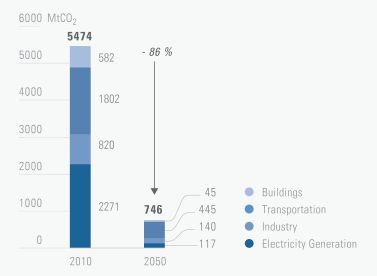On July 8th, the Deep Decarbonization Pathways Project (DDPP) released an interim report that explores the possible pathways to decarbonize the global energy sector. DDPP is made up of 15 Country Research Teams, located in countries that represent 70 percent of global greenhouse gas emissions. Each team has been tasked with analyzing the options for energy-related decarbonization (known as Deep Decarbonization Pathways) for their own country, working independently from their national governments. This report, “Pathways to Deep Decarbonization,” compiles the teams’ preliminary findings, with the collective goal of identifying emissions-reducing actions that help to limit global warming to less than 2° Celsius.
Across all pathways developed by the 15 Country Research Teams, each support three common pillars of energy decarbonization: energy efficiency and conservation, low-carbon electricity, and fuel switching. However, approaches to address these pillars differ by country, based on their socio-economic conditions, resource availability, and cultural ideologies. While the pathways are still in their preliminary stages, if these initial strategies are followed, they would reduce total CO2– energy emissions by 45 percent by 2050. This reduction is unlikely to limit global warming to below 2°C, but it still demonstrates enormous progress. Pathways will be updated through 2015 to incorporate additional decarbonization opportunities, which may get closer to reaching its 2°C target.

U.S. CO2 emissions reduction pathway, by sector
The United States’ pathway calls for significant transformation in the country’s production, delivery, and consumption of energy. For the U.S. to help achieve the global 2°C target by 2050, per capita emissions must decrease to one-tenth their current level (18 metric tons CO2/person, as of 2010). To do this, the report calls for comprehensive federal climate legislation that emphasizes long-term strategic actions and goals. The U.S. Country Research Team modeled a variety of strategies for efficiency, decarbonization, and fuel switching, to be implemented between now and 2050. Findings show that these activities could result in a 74 percent decrease in the energy intensity of GDP, a 97 percent decrease in electricity emissions intensity, and a near tripling of the share of electricity that comes from renewables. Overall, these changes would reduce the U.S.’s energy-related CO2 emissions by 86 percent. To achieve these reductions, near-term priorities include the strengthening of energy efficiency standards for buildings, appliances, equipment, and vehicles. Additional R&D efforts to develop low-carbon fuels for industry and freight will be crucial to reducing CO2 emissions in these sectors as well.
